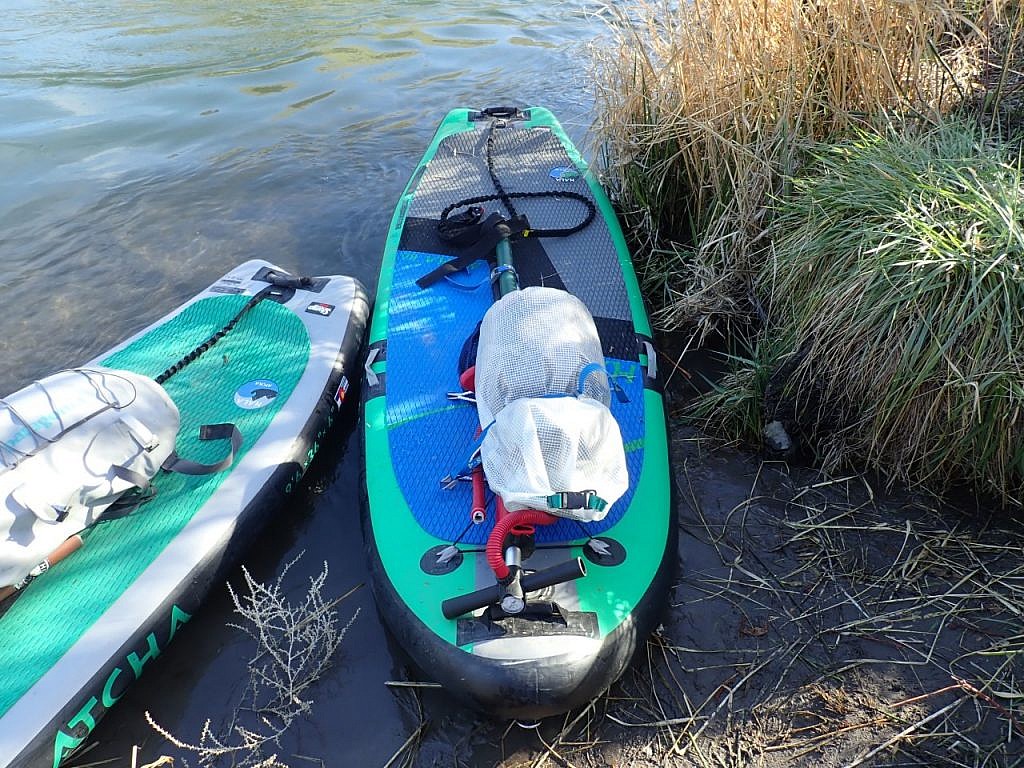
by Scott Sadil
The first time I saw a stand-up paddle board, or SUP, used for fishing, I was down in a dark canyon looking for winter steelhead. I’d been through the run once that morning, failing to touch anything but in no way discouraged as the river was only now dropping into shape, the flow just low enough for effective coverage with a fly. Halfway through a second pass, as I picked my way over the kind of ledgy basalt footing that will leave you gasping, at best, should your boots break free, I glanced upstream and saw somebody moving above a clump of willows.
My first reaction was the spasm of irritation, however brief or unfounded, I generally feel on anyone else showing up where I’m fishing, especially steelheading. Didn’t the guy – or gal – see my truck? Couldn’t they wait, as etiquette prescribes, until I’m done?
Then I saw, yes, it was a guy – and he was on the water, wadered up and, kneeling, riding the current my way.
He slid through a narrow chute and steered with paddle to the far side of the run.
“I’ll stay out of your way,” he called, gliding smoothly downstream, rod strapped to the board, dry bag between his knees.
Hmm.
I had some other thoughts recently when my pal Joe Kelly suggested we take a pair of SUPs to the Deschutes for some off-season trouting.
Mostly, I didn’t like the idea of somehow ending up in the water, riding the current while hypothermia kicked in. I recalled watching a coyote bob downstream through the Rattlesnake Canyon rapid on a single-digit February morning, its head held high until it reached the eddy, swam to shore, climbed up on rocks and shook its fur dry.
I doubted I’d fare as well.
The idea, of course, was not to end up swimming.
I had a little trouble sleeping both nights before the trip. Thirty years an ardent surfer, I had all but quit the sport over the past two decades, while the idea of paddling around on flat water, standing on a wide thick inflatable platform, had looked to me about as exciting as driving a riding lawn mower. Okay, we can all use more exercise. But what about bowling? Or croquet?
Now, it was put up or shut up.
Besides, explained Joe, the plan was simply to reach the other side of the river. Once there we could stash the boards and then have a couple of miles of trout, away from road and campground, all to ourselves.
The promise was almost enough to overlook my fears.
From the rough road heading downstream, the river looked exactly like the Deschutes always looks: big, wide, swift – and not just a wee bit dangerous. It’s just a big trout stream, you tell yourself, glancing up at the spectacular canyon walls.
Real big.
At the launch site we carried boards to water’s edge and climbed into our waders and boots. Near us in the parking lot a guy put up a rod while his buddy stood watching beside some kind of a camera. Somebody famous? I wondered.
Joe shook his head.
“That’s how everyone goes fishing these days,” he said.
We strapped rods and dry bags to the boards. Joe pointed out where we were headed, a narrow eddy where the current crossed the river, caught the edge of a rock, and created a deep pool alongside the bank. If we started across high enough, all we had to do was ferry to the other side.
“Piece a cake,” said Joe, standing on his board and paddling upstream.
I climbed aboard my own board and stayed down on my knees. A man needs to know his limits. I worked my way up to the seam line, then turned into the current.
“No hurry,” said Joe. “Just take your time.”
When I reached the far bank, the pool was deeper than it looked up tight to the winter-bleached grass. I slid off the board, tangled a leg around my dry bag, and tumbled in.
Dragging his board up the bank, Joe turned and looked my way with an expression I’d seen often before.
Is he okay?
Once the boards were secure, we headed downstream and, one by one, found our fair share of trout.
The winter sun soon warmed up my wet sleeves.
______________________________________________________________________________
Gray’s Angling Editor, Scott Sadil, recalls reading that it’s good for the mind to keep trying new things. He just can’t remember the source.
